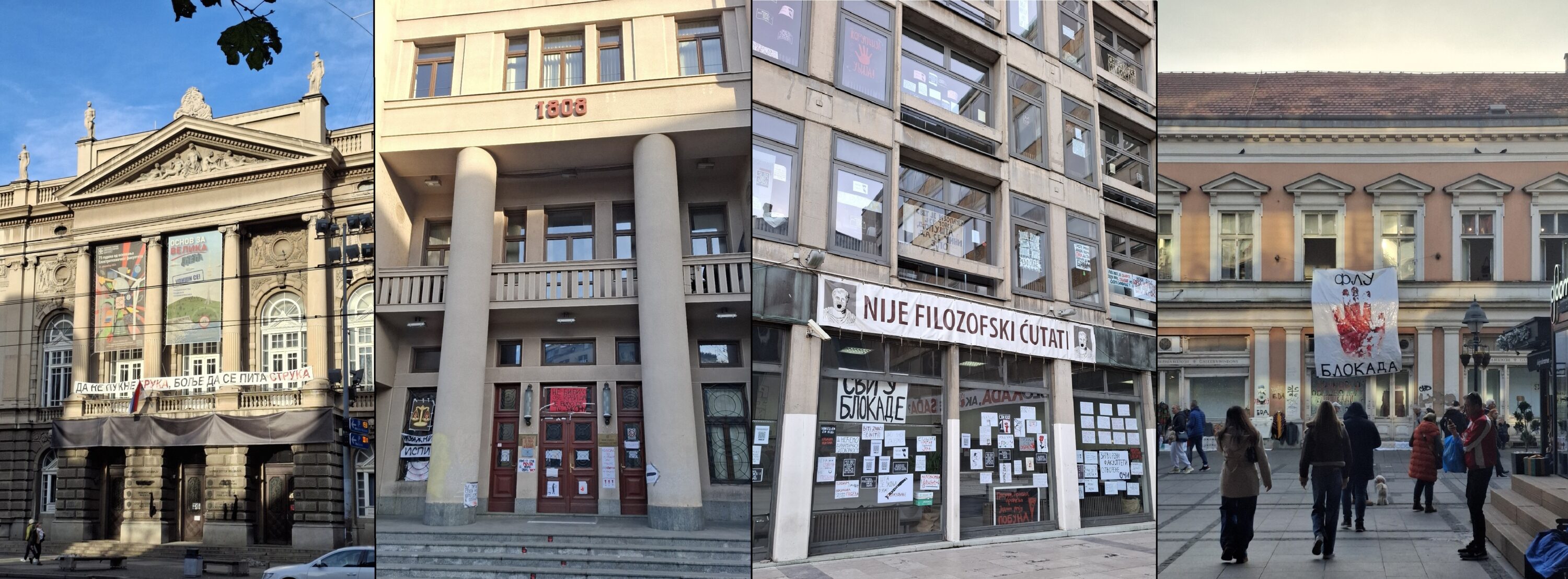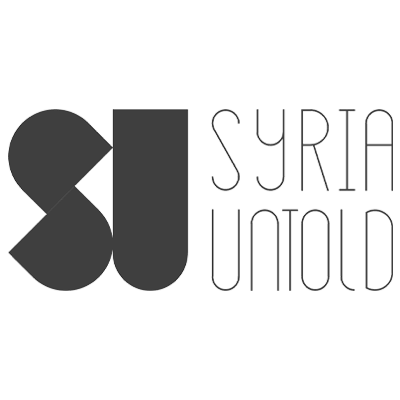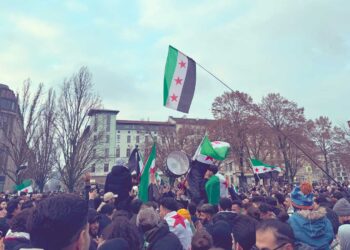On November 1, 2024, a railway station canopy collapsed in Novi Sad, Serbia, killing 16 people. The deadly infrastructure failure—widely blamed on corruption—sparked widespread grief and raised fears about the safety of public spaces. In response, silent protests were held in honor of the victims.
When state-organized violence targeted protesters near the Faculty of Dramatic Arts in Belgrade, students, joined by their professors, responded by blocking the faculty and demanding accountability. The protests quickly escalated into a country-wide movement calling for the depoliticization of public institutions and respect for the law and the Constitution. Paradoxically, the Serbian President, oscillating between autocrat and “stabilocrat”, remains the Constitution’s most notorious violator, underscoring that grassroots solidarity across Serbia is the most powerful weapon against the Leviathan.
Generation Z
Often dismissed as detached digital natives immersed in virtual worlds, students revealed themselves instead as informed, socially engaged, and tech-savvy political actors, unsettling outdated politicians still rooted in the toxic legacy of the 1990s: division, hatred, and entrenched corruption networks.
Generation Z cultivates alternative networks that resist this toxicity, especially in a region shaped by entangled political imaginaries. Though distant from formal political parties, they remain deeply political. Their disruptive, embodied presence in public space is itself a political act, one that creates atmospheric communities and radical friendships in defiance of the banality of mainstream political discourse. Their rejection of party affiliation appears as a strategic response to the systematically fragmented and disoriented Serbian opposition.
Practicing a “politics of swarming”, a decentralized, fluid, and interconnected mode of collective action and decision-making, they move quickly and act decisively, guided by a sharp socio-political and ecological awareness. From the outset, they reminded the president that he lacks the constitutional authority to address their demands.
In a time of globally accelerating fascism, those who do not obey in advance are drawn to voices grounded in truth, with skin in the game, voices that refuse the collective disbelief in the possibility of a better future.
Who joined?
Professors and rectors stood with students, except in Novi Pazar, where the rector cut off heating in blocked university buildings, prompting students to withdraw their recognition of her authority. Despite facing repercussions, including the loss of salaries for refusing to call the police on students, many professors formally joined the blockades.

Families and people across Serbia showed solidarity through deeply personal acts of care: offering food, accommodation, transportation, and emotional support.
Protesters carried placards with diverse demands and slogans. Theatres declared they were protesting “against the absurd,” while artists insisted: “It is not artistic to be silent.” The Independent Cultural Scene, the Belgrade Philharmonic, and bookstores joined the movement. Teachers from elementary and high schools participated, and kindergartens sent messages of support, including one placard held by a little girl: “I have no connections for kindergarten, so I came to protest.”
Farmers joined with slogans like “The farmer feeds, the student defends,” arriving on tractors bearing signs such as “For plowing and guarding students.” Miners, public transport workers, bikers, veterans, athletes, and medical professionals followed. One sign read: “Doctors heal the heart, students heal the system; chiropractors treat the spine,” while pharmacists proclaimed, “We have serum against cobra venom.”
The Bar Association offered free legal aid. The Coalition for Media Freedom voiced support. The IT sector joined with the message: “System error. To avoid shutdown, please reset.”
A turning point came when pensioners joined in powerful intergenerational solidarity. Grandparents marched with grandchildren holding placards like: “When I grow up, I will be a pensioner,” and “Don’t lie to my grandma!” These acts of unity revealed a will for change—yet Serbia could and should do better.
Theatre workers were among the first to respond, observing fifteen minutes of silence before performances, followed by raised red-gloved hands and placards, actions that scandalized the pro-regime director of the National Theatre. Later, theatres across the country canceled performances for a week and launched the Traveling Theatre in Belgrade, a protest procession connecting venues and joined by students, cultural workers, and others committed to solidarity.
Atelje 212 created a stirring performance to the Serbian version of “Let the Sunshine In,” a nod to their 1969 production of Hair (the fourth in the world), with placards echoing the lyrics, such as “Eyes to eyes with the world.”
While protests gained momentum, the government and president proposed “dialogues” that functioned more like manipulative monologues. As one female student, assaulted by regime-linked hooligans, put it, “real dialogue is impossible with a broken jaw.”
In response to car attacks on their members, the Belgrade Philharmonic went on strike. While the attackers remain free, peaceful protesters face swift persecution, despite the regime’s absurdly repeated claim: “Now, all the demands have been fulfilled.” Meanwhile, a member of Parliament from the ruling Serbian Progressive Party dismissed striking cultural workers, especially actors and actresses, as “socially irrelevant snobby producers of bullshit” funded by “our good state.” In contrast, a Radio Belgrade presenter mounted his own acoustic protest by reading a propaganda script live on air, then crumpling and tossing it aside.
Radio Beograd, jutarnji program 2. februara.
Slušati do kraja 🎙️
(Proverio na RTS Planeti, autentično je.) pic.twitter.com/ltZncZjuY1
— Nebojša (@preslicavanje) February 2, 2025
The informal collective Culture in Blockade, operating through plenums, amplified the protests and issued its own demands. They symbolically locked the Ministry of Culture from the outside and reclaimed the Cultural Centre of Belgrade, mirroring students’ liberation of the Student Cultural Center, a building on the verge of privatization and the site where Marina Abramović began her career. From New York, Abramović honored the students as “heroes of today,” reenacting their silent street protest.
A petition for global artistic and academic support was promoted by Wiener Festwochen backing protesters and BITEF festival’s director, having already become persona non grata within the official cultural establishment after Milo Rau opened the Festival with a critique of Serbian and German policies on lithium mining.
Diasporic Pumping
Students have lit a spark in the diaspora, after all, leaving is also a form of protest. Their ongoing “performances” for global attention are deeply moving and creative, as seen in the Where is Justice? gathering at Berlin’s Brandenburg Gate, or through fundraising gestures like the donation from a Yugoslavia-themed Kafana Quiz Night, aimed at supporting teachers facing financial state terror for being deemed too disobedient to receive their salaries.
Thankfully, support foundations for these workers already exist, one of which recently received a donation from Belgrade’s drag queens, who organized a charity show.
The phrase by German dramatist Heiner Müller “wie es bleibt, ist es nicht” (“what remains, is not as it is”) resonates on many levels in Serbia today, where demagoguery no longer finds easy ground.
Diasporic support also came from the group Academic Solidarity with Students from Serbia. Yet early efforts to mobilize institutional political or academic backing were met with resistance. For example, a solidarity letter from Serbian students was promptly removed by the Free University of Berlin’s student group, while the Berlin University of the Arts canceled a planned discussion, fearing repercussions. Such reactions are unsurprising, after all, the Free University had already canceled a talk by UN Special Rapporteur Francesca Albanese on the occupied Palestinian territories, raising serious questions about just how “free” the institution truly is.
Unpacking the Class Question
Solidarity is the protests’ most vital force. In that spirit, ecological activists, mainly from rural areas, often cooked for students, temporarily setting aside their own causes. A student victory, they understood, would strengthen their battles against Rio Tinto, the demolition of public landmarks like the Old Railway Bridge (already nearly gone), the Ministry of Defence, Belgrade Fair, and others.
This affective wave of solidarity bridged Serbia’s long-standing urban-rural divide, momentarily turning the metropolis and the province into comrades. Students became a unifying force among teachers, farmers, workers, and academics, disrupting the melancholia of class divisions and sparking two general strikes. Though Serbia’s crushed and fragmented unions make it far from a Greek-style model, these intersectional strikes embodied a shared emancipatory potential. Their momentum even impacted supermarket boycotts across ex-Yugoslav countries, revitalizing civil disobedience as a tool of solidarity.
The SPP’s absurd response to the general strike, urging members to dine lavishly and fill their tanks, triggered disbelief among lower-class supporters, many of whom ironically celebrated this grotesque display of wealth. For 13 years, Serbia has been trapped in a Midsummer Night’s Nightmare, with pro-regime media acting as an evil fairy, persuading people to distrust their own common sense. Instead of questioning whether they can afford the proposed purchases, people are encouraged to cheer the president and denounce “foreign mercenaries” supposedly out to destroy the “economic tiger.”
After the March 15 protest, the same voices accused the movement of being driven by elites, as if students under blockade weren’t surviving on donations, and education workers didn’t earn below-average salaries. That same day, the government staged yet another class performance, parading “real” farmers with old tractors to contrast with EU-funded ones bearing modern equipment.
Migratory gaze of a theatre scholar
As someone who once left in search of something better, spending years abroad studying theatre as a space to test the utopian, Serbia now feels like home again. It has become a vast, community-based political theatre, where student plenums have seeded citizens’ assemblies and experiments in direct democracy.
Along the way, I came to realize that theatre is not immune to corruption, especially where power is exercised. It can become rigid, unresponsive, even cowardly, particularly during periods of “systemic irrelevance,” as was painfully evident during the COVID-19 pandemic in Berlin. Losing privilege is hard, but it is far more disheartening when former rebels become obedient, sheltered by the social mantra of solidarity at a safe distance.
In today’s Serbia, theatre and its people have proven their relevance to systemic change. Street theatre has become a central form through which the Jürgen Habermas concept of public sphere is not only reflected but actively reimagined. This performative ecology has achieved what a disillusioned German theatre director Thomas Ostermeier might never have expected from his Enemy of the People.
What many theatre scholars see as spatial or institutional limitation was upended the day after the state deployed sonic weapons against its citizens. The Terazije Theatre opened its doors to the movement, stating: Tonight, we invited our dear audience to complete the silence that was violently interrupted last night.
This Serbian solidarity has become contagious, prompting Yanis Varoufakis to name Serbian students as models of global resistance. Yet solidarity offers no individual safety, especially not in 2025 Serbia. And perhaps, it shouldn’t. Because as long as solidarity persists, there will always be a we.
*This text was written in March 2025 as part of an analysis of the performativity of the students-led protests in Serbia.








